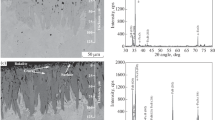Abstract
In this investigation, the microstructure and mechanical properties of AISI420/SAF2507 dissimilar joint produced by TLP process were investigated at different bonding times. For this purpose, TLP process was carried out in a vacuum furnace at 1050 °C using BNi-2 interlayer. The microstructure of different areas of the joint was evaluated by optical microscopy, scanning electron microscopy and energy dispersive spectroscopy. Also, the mechanical properties of the bonded samples were studied using microhardness and shear-tensile tests. It was found that isothermal solidification was completed after 60 min of bonding time. The width of DAZ in SAF2507 steel side was greater than that of AISI420 steel side at all bonding times owing to the easier volume diffusion of boron in to the fully austenitic structure of AISI420 steel as compared with dual crystal structure of SAF2507 steel. At bonding time of 60 min, by regarding the more time for diffusion as compared with 1 min, boride compounds dissolved in the base metals and were discontinued. Thus, the aggregation of boride compounds decreased and as a result the microhardness decreased. In fully isothermal solidification sample, due to the lack of eutectic and intermetallic compounds and creating a homogenous joint (γ-Ni phase), the strength increased. In fact, transformation of athermal solidification to isothermal solidification led to the increase of the joint strength.
Graphic abstract
The OM images indicating the base metals and the bonding area and DAZ of the bonded samples at different bonding times at temperature of 1050 °C for TLP bonding of AISI420/BNi-2/SAF2507.












Similar content being viewed by others
References
K. Hao, C. Zhang, X. Zeng, M. Gao, Effect of heat input on weld microstructure and toughness of laser-arc hybrid welding of martensitic stainless steel. J. Mater. Process. Technol. 245, 7–14 (2017)
Y. Tao Xi, D. Xin Liu, D. Han, Improvement of corrosion and wear resistances of AISI 420 martansitic stainless steel using plasma nitriding of low temperature. Surf. Coat. Technol. 202, 2577–2583 (2008)
S. Kou, Welding Metallurgy Book, 2nd edn. (Wiley, Hoboken, 2003), pp. 449–452
J. Kangazian, M. Shamanian, Mechanical and microstructural evaluation of SAF 2507 and incoloy 825 dissimilar welds. J. Manuf. Process. 26, 407–418 (2017)
M.J.C. Oliveira, R.H.F. Melo, T.M. Maciel, C.J. de Araújo, Microstructural evaluation and mechanical behaviour of dissimilar NiTi-stainless steel joints welded by micro gas tungsten arc welding. Mater. Chem. Phys. 224, 137–147 (2019)
V.D. Vijayanand, J. Vanaja, C.R. Das, K. Mariappan, A. Thakur, S. Hussain, G.V.P. Reddy, G. Sasikala, S.K. Albert, An investigation of microstructural evolution in electron beam welded RAFM steel and 316LN SS dissimilar joint under creep loading conditions. Mater. Sci. Eng. A 742, 432–441 (2019)
D.K. Singh, G. Sahoo, R. Basu, V. Sharma, M.A. Mohtadi-Bonab, Investigation on the microstructure—mechanical property correlation in dissimilar steel welds of stainless steel SS 304 and medium carbon steel EN 8. J. Manuf. Process. 36, 281–292 (2018)
A. Angelastro, G. Casalino, P. Perulli, P.R. Spena, Weldability of TWIP and DP steel dissimilar joint by laser arc hybrid welding with austenitic filler. Procedia CIRP 67, 607–611 (2018)
M. Jula, R. Dehmolaei, S.R. Alavi Zaree, The comparative evaluation of AISI 316/A387-Gr.91 steels dissimilar weld metal produced by CCGTAW and PCGTAW processes. J. Manuf. Process. 36, 272–280 (2018)
A. Kulkarni, D.K. Dwivedi, M. Vasudevan, Study of mechanism, microstructure and mechanical properties of activated flux TIG welded P91 Steel-P22 steel dissimilar metal joint. Mater. Sci. Eng. A 731, 309–323 (2018)
R. Abdolvand, M. Atapour, M. Shamanian, A. Allafchian, The effect of bonding time on the microstructure and mechanical properties of transient liquid phase bonding between SAF 2507 and AISI 304. J. Manuf. Process. 25, 172–180 (2017)
E. Norouzi, M. Atapour, M. Shamanian, A. Allafchian, Effect of bonding temperature on the microstructure and mechanical of Ti-6Al-4V to AISI 304 transient liquid phase bonded joint. Mater. Des. 99, 543–551 (2016)
B. Rhee, S. Roh, D. Kim, Transient liquid phase bonding of nitrogen containing duplex stainless steel UNS S31803 using Ni–Cr–Fe–Si–B insert metal. Mater. Trans. 44, 1014–1023 (2003)
M. Pouranvari, M. Ekrami, A. Kokabi, Solidification and solid state phenomena during TLP bonding of IN718 superalloy using Ni–Si–B ternary filler alloy. J. Alloys Compd. 563, 143–149 (2013)
C. Kang, X. Yuan, M. Kim, Microstructure and XRD analysis of brazing joint for duplex stainless steel using a Ni–Si–B filler metal. Mater. Charact. 60, 923–931 (2009)
M. Arafin, M. Medraj, D. Turner, P. Bocher, Effect of alloying elements on the isothermal solidification during TLP bonding of SS 410 and SS 321 using a BNi-2 interlayer. Mater. Chem. Phys. 106, 106–109 (2007)
K. Saida, Y. Zhou, T.H. North, The influence of base metal grain size on isothermal solidification during transient liquid-phase brazing of nickel. J. Mater. Sci. 28, 6427–6432 (1993)
X. Yuan, C. Kang, M. Kim, Microstructure and XRD analysis of brazingjoint for duplex stainless steel using a Ni–Si–B filler metal. Mater. Charact. 60, 923–931 (2009)
X. Yuan, M. Kim, C. Kang, Microstructural evolution and bonding behavior during transient liquid-phase bonding of a duplex stainless steel using two different Ni-B based filler materials. Metal Mater. Trans. 42, 1310–1324 (2011)
A. Ghoneim, O. Ojo, Microstructure and mechanical response of transient liquid phase joint in Haynes 282 superalloy. Mater. Charact. 62, 1–7 (2011)
X. Yuan, M. Kim, C. Kang, Characterization of transient-liquid-phase-bonded joints in a duplex stainless steel with a Ni–Cr–B insert alloy. Mater. Charact. 60, 1289–1297 (2009)
Acknowledgements
We would like to extend our appreciation to Mr. Ali Karimi for proofreading and also the assistance he rendered in editing the article.
Author information
Authors and Affiliations
Corresponding author
Additional information
Publisher's Note
Springer Nature remains neutral with regard to jurisdictional claims in published maps and institutional affiliations.
Rights and permissions
About this article
Cite this article
Jafari, M., Rafiei, M. & Mostaan, H. Effect of Solidification Mode on Microstructure and Mechanical Properties of AISI420 Steel to SAF2507 Steel Dissimilar Joint Produced by Transient Liquid Phase. Met. Mater. Int. 26, 1533–1544 (2020). https://doi.org/10.1007/s12540-019-00406-z
Received:
Accepted:
Published:
Issue Date:
DOI: https://doi.org/10.1007/s12540-019-00406-z




